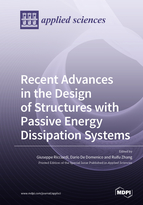Recent Advances in the Design of Structures with Passive Energy Dissipation Systems
A special issue of Applied Sciences (ISSN 2076-3417). This special issue belongs to the section "Civil Engineering".
Deadline for manuscript submissions: closed (31 January 2020) | Viewed by 54944
Special Issue Editors
Interests: passive energy dissipation systems; random vibration theory; seismic design of structures
Interests: performance-based seismic design; seismic isolation; earthquake engineering; innovative structural control systems; limit-state behavior of reinforced concrete structures; strengthening techniques of reinforced concrete structures
Special Issues, Collections and Topics in MDPI journals
Special Issue Information
Dear Colleagues,
Passive vibration control plays a crucial role in earthquake engineering. Common solutions include seismic isolation and damping systems with various kinds of devices, such as viscous, viscoelastic, hysteretic, and friction dampers. These strategies have been widely utilized in engineering practice, and their efficacy has been demonstrated in mitigating damage and preventing the collapse of buildings, bridges, and industrial facilities. However, there is a need for more sophisticated analytical and numerical tools to design structures equipped with optimally configured devices. On the other hand, the family of devices and dissipative elements for seismic protection keeps evolving as a result of the growing performance demands and new progresses achieved in material science and mechanical engineering. As for emerging technologies, negative stiffness devices, self-centering devices, inerter-based systems, and energy sinks are just a few examples.
This Special Issue aims to collect contributions to the development and application of seismic protection strategies for structures, covering both traditional and innovative devices. In particular, the desired topics include, but are not limited to, experimental or theoretical investigations of high-efficient dampers and isolation bearings; optimization of conventional or innovative energy dissipation devices; performance-based or probability-based design of damped structures; application of nonlinear dynamics, random vibration theory, and modern control theory for the design of structures with passive energy dissipation systems; critical discussion of implemented isolation/damping technologies in significant or emblematic engineering projects.
Prof. Dr. Giuseppe Ricciardi
Dr. Dario De Domenico
Dr. Ruifu Zhang
Guest Editors
Manuscript Submission Information
Manuscripts should be submitted online at www.mdpi.com by registering and logging in to this website. Once you are registered, click here to go to the submission form. Manuscripts can be submitted until the deadline. All submissions that pass pre-check are peer-reviewed. Accepted papers will be published continuously in the journal (as soon as accepted) and will be listed together on the special issue website. Research articles, review articles as well as short communications are invited. For planned papers, a title and short abstract (about 100 words) can be sent to the Editorial Office for announcement on this website.
Submitted manuscripts should not have been published previously, nor be under consideration for publication elsewhere (except conference proceedings papers). All manuscripts are thoroughly refereed through a single-blind peer-review process. A guide for authors and other relevant information for submission of manuscripts is available on the Instructions for Authors page. Applied Sciences is an international peer-reviewed open access semimonthly journal published by MDPI.
Please visit the Instructions for Authors page before submitting a manuscript. The Article Processing Charge (APC) for publication in this open access journal is 2400 CHF (Swiss Francs). Submitted papers should be well formatted and use good English. Authors may use MDPI's English editing service prior to publication or during author revisions.
Keywords
- Seismic isolation
- Energy dissipation devices
- Tuned mass damper
- Negative stiffness device
- Inerter system
- Damped structures








